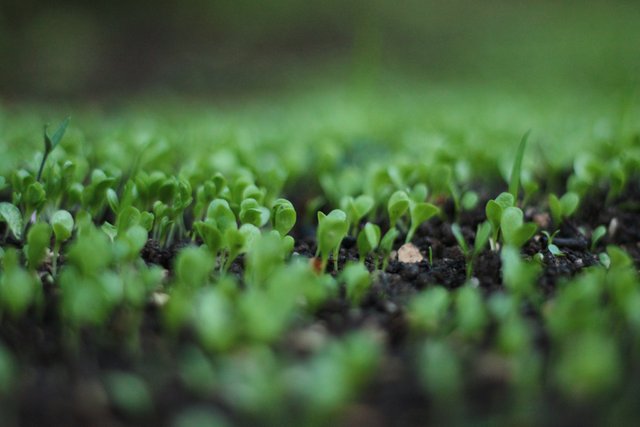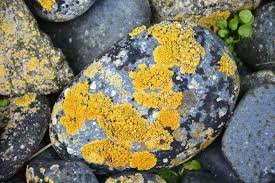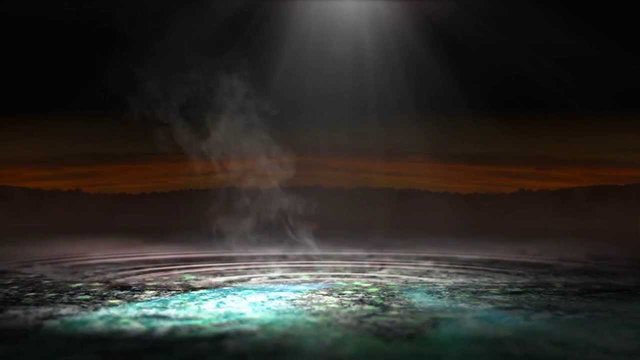Everything on Earth starts with the soil.

For billions of years the living topsoil has been accumulating naturally, and in only the last one hundred years we have abused its bounty to the point that in some places it is literally running out.
Soil doesn’t just happen by chance, it is manufactured through a very deliberate process based around the work of what is collectively called the “soil food web”. There is another universe under our feet made up of an intricate web of life encompassing tiny micro-organisms, or microbes, that are charged with the most important work of all — growing soil.
Think about the soil food web like the web of life in the ocean. The big fish eats the little fish on down to the plankton that represents the base of the oceanic food chain. Microbes are the “plankton of the soil”, or the base of the terrestrial food web. Research shows that this is literally true.
Microbes support the earthworms that feed the birds, which inevitably nourishes and culminates in people. Now make the connection that essentially every modern conventional farming practice works against the fundamental soil building activity of microbes — tilling, fungicides, artificial fertilizers, mono-cropping, and the list goes on.
How did our agriculture become so counter-intuitive? How did we get so far away from the point?
Back in the 1500’s Leonardo da Vinci said, “We know more about the movement of celestial bodies than about the soil underfoot.” This statement remains true to this day, with estimates telling us that science has only identified 5 percent of bacteria and 10 percent of fungal species based on the rate of discovery. Why are we so malicious towards something we know so little about?

Evidence of how little we know is all around us. For instance, the description of one of the central concepts in our understanding of Nature was recently redefined. The term “symbiotic relationship” was first used by Albert Bernhard Frank in 1877 to describe lichens. For almost 150 years lichens were understood to be an alliance between a single fungi and a single algae, but a pioneering scientist named Toby Spribille recently overturned this textbook understanding with the discovery that a lichen is a symbiont, not of two organisms, but of three. It is a fascinating story of assumption and finding new ways to look at things, as with most realities in the natural world the truth was hiding in plain sight.
Due to their size and diversity, studying microbes is notoriously difficult, as evidenced by the lack of authority in soil science and the ostensible “experts” in the realm of compost tea brewing. Compounding the issue is the fact that for most people, microbes are out of sight out of mind. For example, it is not uncommon to meet a gardener who is unaware of the role of microbes in making compost or that the soil is alive to begin with!
The effort of defining life is a precarious motivation, as Nature does not fit neatly into boxes. For much of the twentieth century the “tree of life” was segmented into two main branches — the eukaryotes that contain membrane-bound organelles made up of organisms that are familiar such as animals, plants, fungi and protozoans; and the prokaryotes that lack membrane-bound organelles thought to be comprised mostly bacteria.
In 1977 a team led by Carl Woese first classified “bacteria-like” organisms he called archaea as a separate group of prokaryotes based on the sequences of ribosomal RNA genes. Ribosomes are large and complex molecules that convert the DNA message inside cells into a chemical product. Because ribosomes are so critical to the functioning of living things, they are conserved and not prone to rapid evolution, making them ideal to study in the effort to unlock the secrets of bacterial evolution.
By comparing the slight differences in ribosome sequence among a wide diversity of bacteria, groups of similar sequences could be found and recognized as a related group. When DNA technology was first adopted as a means of studying microbial life scientists discovered that the RNA sequences of archaea were no more similar to bacteria than they were to starfish or sunflowers. In fact, archaea RNA in many ways appeared more similar to eukaryotes. This is quite the conundrum for those attempting to put Mother Nature in a box.

In April of 2016 a New York Times headline read, “Scientists Unveil New Tree of Life”. The study introducing these new ideas was published in the journal Nature Microbiology and read, in part, “Organisms from novel lineages have eluded surveys, because many are invisible to these methods due to sequence divergence relative to the primers commonly used for gene amplification.” In other words, new methods of discovery were needed and science simply did not know how to look for them or grow them in the laboratory.
The word archaea comes from a Greek term meaning “ancient things”, as the first representatives of archaea discovered were methanogens, or organisms that produce methane. Because of this association, archaea are often described as extremophiles. Many are extreme, being found present in temperatures close to boiling, the guts of animals, and extremely salty water — some archaea can even survive inside granules of salt!
But archaea are also found in common soil, some even postulate that they “eat ions” rather than just the organic matter like in the compost heap. This is a particularly fascinating idea considering the discovery of electric microbes that were first discovered in 1987 by Derek Lovely and his lab at the University of Massachusetts.
It is this ability to survive in extreme environments that highlights archaea’s potential importance to the origins of life on Earth. The atmosphere that gave rise to life billions of years ago before there was an oxygen-based ecosystem is thought to have been made up of methane, ammonia, and seawater, known as the “primordial soup”, then sparked into life by pressure or electricity. Scientists speculate that archaea were the original organisms that formed during these times due to a gradual development of molecules with increasing complexity.

One of the most important pieces of experimental evidence to support the primordial soup theory came in 1953 when a graduate student named Stanley Miller under the guidance of his professor, Nobel laureate Harold Urey, performed an experiment now known as the “Miller-Urey experiment”. They used simple organic molecules like amino acids and mimicked the primitive conditions thought to be present in Earth’s early atmosphere with a mixture of methane, ammonia, water vapor, and hydrogen. They then sparked electrical flashes to simulate lightning and when they analyzed the solution after a week they found that organic amino acids had formed spontaneously from the inorganic raw materials.
Of course, the primordial soup theory does not account specifically for how life was born from the original amino acids, and it has many critics. For example, in his book Intelligent Universe the British astrophysicist Fred Hoyle compares the likelihood of life appearing on Earth by chemical reactions in this way, “A junkyard contains all the bits and pieces of a Boeing 747, dismembered and in disarray. A whirlwind happens to blow through the yard. What is the chance that after its passage a fully assembled 747, ready to fly, will be found standing there?”
Science is an undeniable tool in our desire to describe and explain living systems; but it is born of an anthropocentrism that creates blind spots and false certainty. Namely, that if we do not know to test for it, or if the test we develop cannot be replicated in the exactness expected by the mighty scientific method, “it isn’t there”. Too many well-meaning people stifle the collective scientific imagination believing that if it has not been discovered it cannot be true. Try proposing the merits the radionics of Dr. Albert Abrams or the biodynamic methods of Dr. Rudolf Steiner with the wrong crowd!

The imagination of the human spirit is unstoppable, but modern popular science does its very best through the dogma of deduction. Without peer reviewed studies published in major scientific journals, those who seek to expand our understanding of life and the natural world are left carrying the burden of proof for things that do not fit neatly into the confines of academia. In other words, popular science must remove data from context in order to study it, but in the end it is only the context which gives the data its value.
Enter James Francis Martin, or Jim as he was known, an eccentric inventor from Texas who, according to family records was born on December 13, 1894. There is quite a history, and many modern product formulators, behind the story of his creation of an enzymatic biocatalyst he called “the living water”.
It was derived from seawater, cow manure and yeast — simple ingredients that were transformed by a fermentation process into a substance with remarkable qualities. Some of the results claimed from using this seemingly magical substance read almost as fiction, but he was issued a patent in October 1959 — number 2,908,113 — and during his lifetime attracted the attention of many influential business people as well as renowned scientists to his work.
As described in the patent, Martin’s process propagated microbes by combining filtered cow manure with fresh seawater containing algae, which was fermented in a digester with regular infusions of cow manure along with large volumes of fresh water and small quantities of yeast. The liquid was then further diluted with fresh water until only byproduct and enzymes were left.
Given our understanding of archaea there is some logic to explain the fantastic claims made around Mr. Martin’s substance. Ruminants have compartmentalized stomachs that permit anaerobic archaea to thrive. Cow manure contains methane and ammonia, but even more interesting is the reference in Martin’s patent amendments stressing that bacteria found in manure from milking cows are unique. All cattle need calcium to build their bones, but lactating and pregnant cows have an exceptional need to make calcium for both milk and the bones of the calf. In other words, the archaea from milking cows are understood to be stronger.
This presents an interesting discussion for another article in regards to investigating the relative abilities of lab-derived microbes in gardening products versus those found in Nature. It is also interesting to note that biodynamic practitioners also prefer the manure from milking cows for use in making the biodynamic preparation BD500 horn manure. Again, the idea being that the milking cow organism is considered stronger in order to provide for its young. Many women who have experienced child birth out there would probably agree!
Those who have looked closely at Mr. Martin’s process believe that the ingredients produce a special form of highly reactive oxygen through the fermentation process of the archaea, much like those proposed to have formed billions of years ago in the primordial soup. The archaea received the hydrogen for photosynthesis directly from the water and released the single oxygen from the water molecule into the atmosphere as waste. The atomic oxygen (O1) formed from this chemistry is very reactive and unstable, but eventually began to combine to form the molecular oxygen (O2) that we breath and the ozone (O3) that shields us from the ultraviolet rays of the sun and encapsulates our current atmosphere.
During his career, Dr. Carl Oppenheimer specialized in bioremediation, or the use of biological means to clean up pollution such as oil spills or other forms of toxic waste. Through acquaintances Dr. Oppenheimer tested some of Mr. Martin’s special soil activator with exceptional results. He proposed that the atomic oxygen produced through the process stimulated microbes to grow rapidly, allowing them to operate aerobically in environments they otherwise could not — think scuba tank for microbes. This may be why Mr. Martin was able to utilize it, not only in growing soil and making the desert bloom, but in cleaning up oil spills and mitigating dangerous chemicals. To this day, science remains mystified about exactly how the process works.
Popular science tends to scorn and ignore the questions that cannot be answered, but this happens to be where the most fascinating stories lie. Look into the biological transmutation of Louis Kervran or the implosion research of Viktor Schauberger. It is a travesty that more people have heard of Nikola Tesla through a car company named after him than due directly from his discoveries!

The question becomes, is it more important to know the mechanism of Jim Martin’s “living water”, or to put it into use to help clean up and regenerate our world?
The truth is, the more we study Nature, the harder she becomes to define. Here is a mantra worth living by, “As long as it works”.
…
The future is open source and decentralized. Evan Folds pursues his passion of integrating the natural spiritual world with human centered technology by developing and sharing content shared across the digital landscape on Facebook, Twitter, and LinkedIn.
UPVOTES appreciated.
So much to be done to assist Gaia!
Downvoting a post can decrease pending rewards and make it less visible. Common reasons:
Submit
I always like reminding religious people that 6 inches of top soil is what determines our survival.
Downvoting a post can decrease pending rewards and make it less visible. Common reasons:
Submit